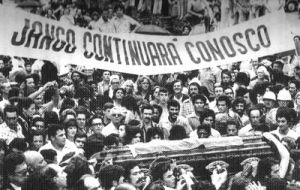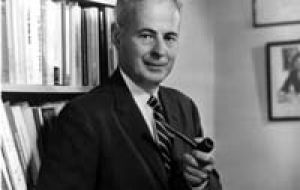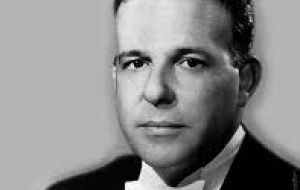MercoPress. South Atlantic News Agency
The 1964 “Made in Brazil” coup and US contingency support-plan if the plot stalled
 At Jango's burial in Sao Borja thousands took to the streets
At Jango's burial in Sao Borja thousands took to the streets Do friendly countries make contingency plans for landing Marines in the big cities of other friendly countries? Even if it’s only to be done in a worthy cause—like supporting a military takeover of a democratically-elected government? During the recent trip to Washington of Brazilian President Dilma Roussief there was a public effort by both sides to “accent the positive” but perhaps there should have been some hard questions behind closed doors.
The CIA recently released “sanitized” documents on American involvement in Brazil’s 1964 coup, and there’s bad news for the Brazilians although not the bad news that might be expected. Instead of supporting what is often claimed in Brasilia—that the U.S. hijacked a democratically-elected Brazilian government—the CIA messages, if they can be believed, show that the Brazilians did most of the heavy lifting in the destruction of their own democracy. The U.S. military had plans for more, much more, but never had to act because the Brazilian generals did such a good job at coup execution. The CIA records, part of a document declassification last summer that can be viewed at the Lyndon Baines Johnson Presidential Library in Austin, mostly concern troop movements on the eve of the coup and internal politics of the Brazilian Army. Prior releases by the U.S. State Department and Department of Defense have already fleshed out many of the details of April 1964’s “Operation Brother Sam,” as the U.S. effort to overthrow liberal President Joao Goulart was termed. And yes, to address the obvious concern, the part the US played is undeniable.
As Brazilian school children learn, Washington dispatched an aircraft carrier to the South Atlantic—“to establish a U.S. presence in this area when directed and carry out such additional tasks as may be assigned,” as the Pentagon euphemistically described the mission in secret cables at the time. 250 12-gauge shotguns were crated for delivery to Brazilian police, for riot control in case the people of the country weren’t in agreement with the generals. That, the school kids may not know. Fuel tankers were also dispatched to the nearby coast of Uruguay in case of need by the mutineers, and 110 tons of military supplies were prepared for airlift, including tear gas. None of that is new, although it may not presently be part of the Brazilian school history curriculum.
Nor is the back-up plan discussed by Washington, to land U.S. Marines in Sao Paolo, if necessary. The contingency, as presented to the White House: “U.S. forces will be committed into Brazil to provide protection for the terminus of a U.S. supply line. Force will be applied as necessary to protect U.S. forces, the logistic support base and/or to attain achievement of objectives.” An indication of the importance that the US ascribed to its operation was that the Air Force officer tasked with arranging some of the logistics was Paul Tibbits, who flew the plane that dropped the atomic bomb on Hiroshima.
There were apparently no plans, you’ll be happy to know, to nuke Rio, where the leftist president was headquartered. But the contingency plan called for, if necessary—and if approved by then-President Johnson—American air strikes in Brazil, to be flown from Argentine bases. As often happens when the Pentagon begins war planning, it’s not clear if the Argentines were ever consulted. Nonetheless the U.S. knew what the targets for military intervention would be. “The principal objective area will be Sao Paolo. . . . based upon current intelligence, [Sao Paolo] will provide U.S. forces the necessary facilities for air and sea logistical actions”—which apparently included air strikes—“in support of Brazilian forces. Alternate objective areas, depending on the situation, may be the Rio de Janeiro or Porto Allegre area”.
None of the U.S. plans were in fact necessary. A cable from the US ambassador the first day of the coup quotes Brazilian General Humberto Castelo Branco, the leader of the uprising, “He has told us that he doesn’t need our help.” The next day a U.S. Joint Chiefs of Staff memo summed up the situation: “Package of arms and ammunition continue to be held at McGuire [U.S. Air Force Base] pending Ambassador Gordon’s determination of whether Brazilian military forces or state police forces will require early U.S. support . . . Carrier task force continue[s] toward South Atlantic until ambassador states that port calls or other U.S. demonstrations of naval power are definitely not needed.” Then there was the ominous comment, apparently referring to CIA attempts at covert destabilization, “Only that part of political movement which ambassador considers essential to current situation [to] be continued.”
The new CIA documents recount on the same day, almost in real time, a meeting between President Goulart and General Amaury Kruel, commander of the pivotal Second Brazilian Army, the only major force which so far had not changed sides to support the rebels. The President “said he wished to retain Kruel’s support,” the CIA summary of the meeting reported, but Kruel wanted concessions about the political company the president was keeping. “Goulart is said to have replied that before he made any changes in his political alliances he would first have to consult with the leadership of the General Worker’s Command. At this Kruel broke off the conversation and said he no longer felt obliged to follow Goulart out of personal friendship or as commander of the Second Army.” And that was either the beginning or the end of the coup, depending to your point of view. Kruel led his army into the rebel camp. Goulart fled the country, never to return. Within a week, U.S. Secretary of State Dean Rusk was cabling the U.S. Ambassador in Rio, “Navy Task Force instructed to stop, engage in some kind of limited exercise to provide cover for sailing, and then turn back. We intend keep original purpose permanent secret.” That did not happen.
And, of course, even without the Marines, the revolt had received substantial U.S. backing. The CIA has previously been implicated in fomenting street demonstrations against Goulart, who wanted to take the country left, yes, but probably not into the Communist camp. Goulart’s biggest mistake may have been that his timing was poor. Coming as Vietnam heated up, a couple of years after the Bay of Pigs and a year before the Sukarno coup in Indonesia—all featuring a heavy American contribution—Brother Sam wanted to lock the fence on his own “back yard.” The guard dogs were, in fact, already there.
Many of the officers who helped overthrow Goulart, like Castelo Branco himself—who would serve as president of the military junta—had been trained by the U.S. or served with the Brazilian Expeditionary Force that fought with Allied troops in Italy during World War II. Castelo Branco had been the BEF’s executive officer, and at the time of the 1964 coup the American communications indicate that his son, a Brazilian naval officer, was receiving advanced training in California. The CIA happily described Brazil’s new military leadership for the White House as the situation evolved: “The president [Castelo Branco] appointed Lt. General Costa e Silva as Minister of War. He is the senior army general on active duty and is highly respected. He is a centrist, pro-US, and a staunch anti-Communist. Air Force General Correa de Mello was appointed Minister of Air. He is also US-trained, and is militantly anti-Communist. Admiral Rademaker, the newly-appointed Minister of Navy, has been strongly anti-Goulart, pro-US and anti-Communist.” A clean sweep.
A new Bank of Brazil leader and Petrobras president—a general—were appointed, as well as a new Labor minister. Engineers, the CIA said, would replace ideologues. Plans to offer Brazil foreign debt relief were made, in turn, by the U.S. and allies. “A return to financial order is a precondition to any long run progress and is not impossible,” the CIA told the White House on the second day after the coup. “Beyond that, a new government will also have to show progress in coping over the long run with such chronic problems as the backward northeast and agrarian reform.”
Flash forward a few days: security forces had ransacked the New York Times bureau, after doing the same to major national newspapers, and Secretary of State Rusk was wondering privately how far the new military government might go. “New York Times representative phoned today informally,” he wrote in a cable to the American ambassador, “concerning government invasion of their Rio offices and search of their files; also concerning censorship allegedly being set up on correspondents (a sure way, it seems, to provoke unfriendly foreign press treatment.) Also comments on wave of arrests, and on rumored threat to close Congress if uncooperative on Presidential changes. Developments such as these give poor image of Brazil and not encouraging for future.” In a separate memo the same day, Rusk wrote to the ambassador, “We think it important that every feasible effort be made to preserve at least the color of legitimacy for whatever government is chosen to take over.” Meanwhile the CIA was reporting, “The military high command continues to be intransigent. Objective to remove Communists from Congress and government or state offices.” The CIA also reported, accurately “”In all likelihood the majority of Brazilians will support the new administration”.
In a prediction of what coup plotters would probably describe as the good the revolt would do, the CIA told the White House: “The government will be under heavy pressure to find solutions to the overwhelming socio-economic problems. The chances of constructive effort in this regard are considerably increased, however, and a majority of the forces now in power probably favor moderate reforms as a means of allaying extremist demands for radical change.“ In the words that echo every time the U.S. plots or executes a coup, CIA agents added, “The change in government will create a greatly improved climate for foreign investments.”
“Centrist” historians might argue that the coup was the foundation of the economic progress Brazil sees today. But Goulart, who died in exile on a farm in Argentina, would have argued that his way, support to workers and more immediate economic change, would have gotten Brazil there faster. Goulart was the last liberal Brazilian president until the very successful tenure of Lula da Silva. The most interesting question from the new cables may be, however, who the CIA’s sources were. It’s as if ministers and generals left meetings and went to the closest phone and called Langley.
What is known is that the American military attaché in Brazil at the time was Colonel Vernon Walters, the British-born U.S. Army linguist who was confidant to presidents Eisenhower and Truman, and later became General Walters, deputy director of the CIA, U.S. Ambassador to Germany when the Berlin Wall fell, and even Ronald Reagan’s UN Ambassador. Colonel Walters was the American go-to guy for disaffection. He spoke Spanish, German and Portuguese, and had been the translator in Italy and in Washington, during the war, for many of the same senior Brazilian officers who led the coup. His cables are noticeably missing from releases so far.
The real value of disclosures like these may be historical in a different sense than pinpointing where the Marines would land. Brazil has recently surpassed the United Kingdom as the sixth largest economy in the world. Brasilia has burst on the world scene and in lieu of playing perennial victim to the U.S.’s big bad Brother Sam, it may be time for Brazilians to look at their own country the way others have seen it. Some of the insights by CIA and other American operatives are particularly telling. Others are not.
A State Department cable described the new President Castelo Branco as “short, stocky, very short neck and large head gives him appearance of being hunchbacked,” while the CIA writes movingly of one of the main coup plotters, the conservative businessman Adhemar de Barros, three-time governor of Sao Paolo State: “A dynamic, voluble individual with a forceful, pleasant personality, Barros is an ideological conservative whose notorious opportunism has led him to cooperate with every conceivable type of politician. His terms in public office have usually been marked by driving energy and exceptional administrative ability, but notorious large-scale personal dishonesty.” That was sent to the White House three days into the coup. Pretty good analysis on the run, and it might even be true.
So, although the messages don’t make a perfect case for U.S. subversion, they do make good reading.
All in all, however, even though planned and financed in the U.S., with American spare parts provided, if you can believe the U.S. government, which is a big if, this coup appears to have been mostly “Made in Brazil.”






Top Comments
Disclaimer & comment rules-

-

-

Read all commentsTWIMC
Apr 15th, 2012 - 06:30 am 0Article says:
“Goulart, who died in exile on a farm in Argentina”
Article should say:
“Goulart, who died, shortly after being murdered, in exile on a farm in Argentina”
Article might say:
Apr 15th, 2012 - 08:36 am 0“Goulart, who was murdered on a farm while exiled in Argentina”.
These words salad are neither proof nor documents,just reflects CIA's own opinions & sightseeings & reports.
Apr 15th, 2012 - 09:42 am 0Thats well known that CIA have had free spaces inability on some intelligence areas..
I don't guess the CIA knows the deep relations..can't reveal even if it knows them...
Commenting for this story is now closed.
If you have a Facebook account, become a fan and comment on our Facebook Page!